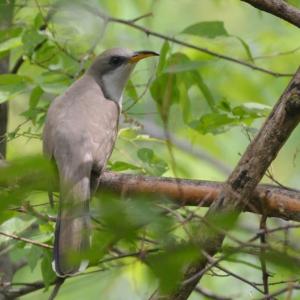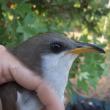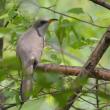Maine’s Mysterious Cuckoos
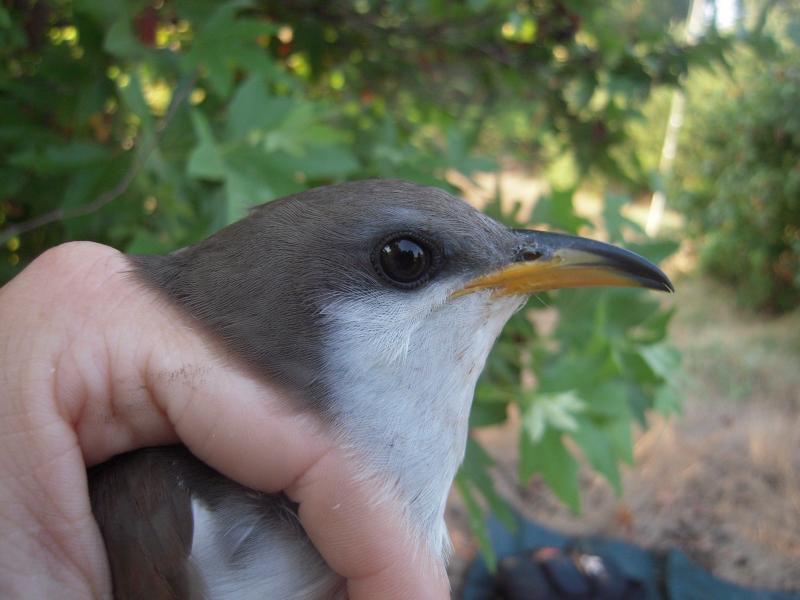 Yellow-billed cuckoos are well-named for their substantial yellow bill. The bird in this photo was captured for banding and then released. Photo by Mark Dettling/Point Blue Conservation Science courtesy of Wikimedia Commons.
Yellow-billed cuckoos are well-named for their substantial yellow bill. The bird in this photo was captured for banding and then released. Photo by Mark Dettling/Point Blue Conservation Science courtesy of Wikimedia Commons.
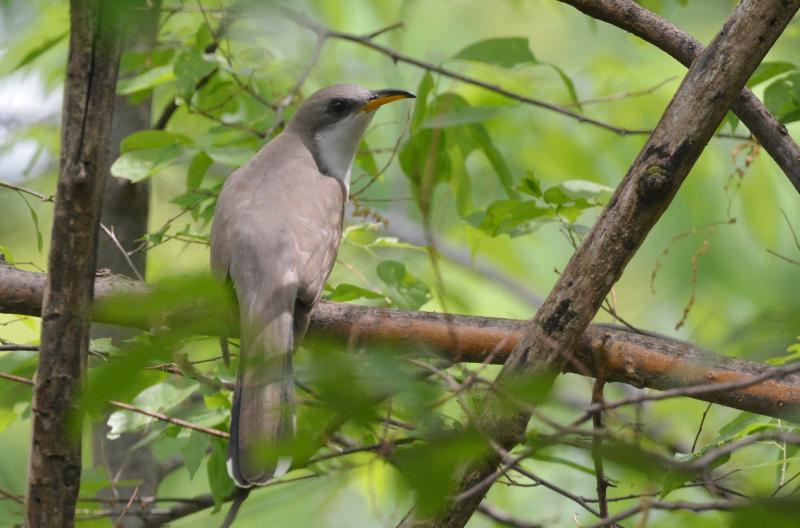 Yellow-billed cuckoos are skilled at remaining hidden in leafy trees and shrubs, but occasionally, with patience and a little luck, it’s possible to get a good view or even a photo. Photo by Andy Reago & Chrissy McClarren courtesy of Wikimedia Commons.
Yellow-billed cuckoos are skilled at remaining hidden in leafy trees and shrubs, but occasionally, with patience and a little luck, it’s possible to get a good view or even a photo. Photo by Andy Reago & Chrissy McClarren courtesy of Wikimedia Commons.
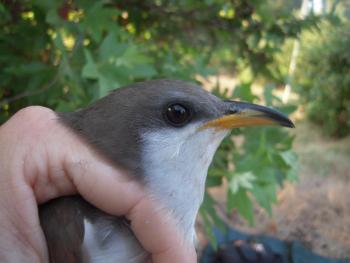 Yellow-billed cuckoos are well-named for their substantial yellow bill. The bird in this photo was captured for banding and then released. Photo by Mark Dettling/Point Blue Conservation Science courtesy of Wikimedia Commons.
Yellow-billed cuckoos are well-named for their substantial yellow bill. The bird in this photo was captured for banding and then released. Photo by Mark Dettling/Point Blue Conservation Science courtesy of Wikimedia Commons.
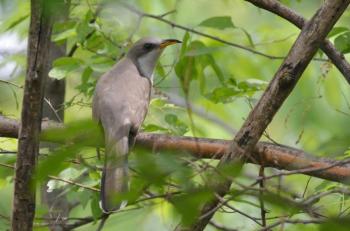 Yellow-billed cuckoos are skilled at remaining hidden in leafy trees and shrubs, but occasionally, with patience and a little luck, it’s possible to get a good view or even a photo. Photo by Andy Reago & Chrissy McClarren courtesy of Wikimedia Commons.
Yellow-billed cuckoos are skilled at remaining hidden in leafy trees and shrubs, but occasionally, with patience and a little luck, it’s possible to get a good view or even a photo. Photo by Andy Reago & Chrissy McClarren courtesy of Wikimedia Commons.
Last week, as we were walking our dog during a stay at brother Andrew’s camp on beautiful Parker Pond, the quiet of our walk on the dead-end gravel road was shattered by a emphatic rattling noise coming from the surrounding forest. We paused and looked at each other: yellow-billed cuckoo!
For two years in a row, we have noticed the apparent increase of calling yellow-billed cuckoos in the central-southern Maine area in July. Interestingly, a quick scan of eBird records seems to show that the number of yellow-billed cuckoos reported in Maine this past July was more than twice as many as were found in June.
Why?
Cuckoo species—there are more than 100 that occur worldwide—are generally very secretive and somewhat mysterious creatures. Whenever they make their presence known, it is a treat.
There are two species that breed here in Maine, the more widespread black-billed cuckoo and the less common yellow-billed cuckoo. They are not small birds; both species are roughly the body size of a blue jay but with a much longer tail and a fairly substantial downward curved bill. Yet, they are often very adept at hiding from human eyes, staying very still or skulking cautiously in thick vegetation. Their songs and calls, on the other hand, are loud and easily distinguished, ringing out from forests and shrublands.
The black-billed cuckoo song is likely more familiar to bird enthusiasts here in Maine. It’s a rapidly repeated “cu-cu-cu-cu, cu-cu-cu-cu, cu-cu-cu-cu” ringing across its breeding range, which encompasses about a third of the eastern and central U.S and adjoining regions along the southern edge of Canada.
The yellow-billed cuckoo, in contrast, gives a series of more slowly repeated, hollow “cloo” notes and a rapid rattly knocking. The breeding range of yellow-billed cuckoo is broader, extending south into Mexico and the Caribbean, with scattered populations across the western U.S. but not extending as far north into Canada.
Some of the European cuckoo species are famous for parasitizing other birds by laying their eggs in their nests so that the hosts raise their young, just as brown-headed cowbirds do here in North America. Interestingly, both black-billed and yellow-billed cuckoos are known to occasionally do the same (robins, catbirds, and wood thrushes are known to be hosts). But more typically, they build a nest and raise their own young. Their eggs are very large for their size, an adaptation thought to allow the young to reach fledgling stage very quickly—in under three weeks from the time the egg is laid.
Both yellow-billed and black-billed cuckoos are known to sometimes key in on outbreaks of caterpillars for food. Their prey can include tent caterpillars, the larvae of gypsy moths, and even the caterpillars of brown-tailed moths, the species causing so much misery in many parts of Maine from the irritating skin reactions caused by the hairy larvae.
We have wondered if the mid-summer appearance of yellow-billed cuckoos in south-central Maine could be connected with the outbreaks of brown-tailed moths that have been happening in the region. But it is hard to understand why more of the cuckoos would suddenly start arriving in July. Are they birds that failed in their breeding attempts farther south and moved north to try for a fresh start in a new territory? Are there some individuals that wander around looking for an abundant outbreak of caterpillars to take advantage of and try to nest wherever and whenever they find them? Are yellow-billed cuckoos expanding their breeding range northward as a result of climate change and, if so, will that also impact black-billed cuckoos?
There is much yet to learn about the mysterious cuckoos of Maine, and we look forward to discovering more clues.
Jeffrey V. Wells, Ph.D., is a Fellow of the Cornell Lab of Ornithology and Vice President of Boreal Conservation for National Audubon. Dr. Wells is one of the nation's leading bird experts and conservation biologists and author of the “Birder’s Conservation Handbook.” His grandfather, the late John Chase, was a columnist for the Boothbay Register for many years. Allison Childs Wells, formerly of the Cornell Lab of Ornithology, is a senior director at the Natural Resources Council of Maine, a nonprofit membership organization working statewide to protect the nature of Maine. Both are widely published natural history writers and are the authors of the popular books, “Maine’s Favorite Birds” (Tilbury House) and “Birds of Aruba, Bonaire, and Curaçao: A Site and Field Guide,” (Cornell University Press).


